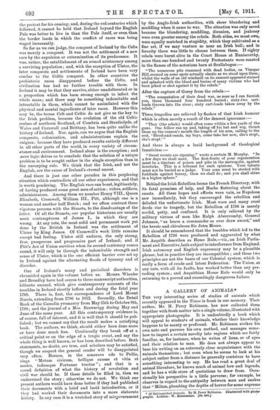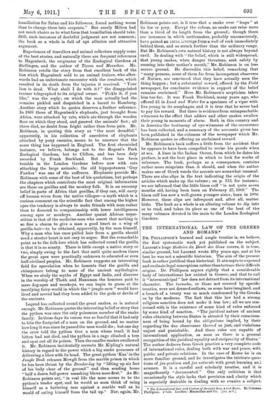A GALLERY OF ANIMALS.*
THE very interesting series of studies of animals which recently appeared in the Times is fresh in our memory. Their author, Mr. H. Perry Robinson, has now collected them together with fresh matter into a single volume, illustrated with appropriate photographs. It is undoubtedly a book which will appeal to students of animals, whether their knowledge happens to be scanty or profound. Mr. Robinson strikes his own note and pursues his own method, and manages some- how to import a certain novelty into regions which are fairly familiar, as, for instance, when he writes of lions, or of apes and their relation to man. He does not always appear to base his writing on an extremely close acquaintance with the animals themselves ; but even when he seems to look at his subject rather from a distance he generally contrives to have something interesting to say. He has read a great deal of animal literature, he knows much of animal lore and legends, and he has a wide store of quotations to draw from. Occa- sionally his perspective is a little perverse; for example, lie observes in regard to the antipathy between man and snakes that " Milton, plumbing the depths of horror for some supreme • Of Distinguished Animal,. By H. Perry Robinso4. Illustrated With photo- graphs. London : W. Heinemann. [64. wt..]
humiliation for Satan and his followers, found nothing worse than to change them into serpents." But surely Milton had not much choice as to what form that humiliation should take. Still, such instances of doubtful judgment are not common ; the book as a whole is full of apt allusion and attractive argument.
Experiences of travellers and animal collectors supply some of the best stories, and naturally there are frequent references to Hagenbeck, the originator of the Zoological Gardens at Stellingen, and the author of Tieren and Menachen. Mr. Robinson retells the story from that excellent book of the lion which Hagenbeck sold to an animal trainer, who after- wards had an unfortunate encounter with the creature, which resulted in its death from the injuries it received. " Your lion is dead. What shall I do with it P" the disappointed trainer telegraphed to its original owner. " Pickle it, if you like," was the reply ; on which the man actually had the remains pickled and despatched in a barrel to Hamburg. Another story which be quotes deserves a further reference. In 1868 three of Hagenbeck's elephants, just brought from Africa, were attacked by rats, which ate through the wooden floor on which they stood, and gnawed the animals' feet ; all three died, no doubt from fright rather than from pain. Mr. Robinson, in quoting this story as "the most dreadful," apparently, in his collection of anecdotes of elephants attacked by puny enemies, seems to be unaware that the same thing has happened in England. The first chronicled instance, we believe, belongs not to the Regent's Park Zoological Gardens, but to Clifton, and has been duly recorded by Frank Buckland. But there has been trouble in the London Gardens before now with rats attacking the large animals ; the old hippopotamus ' Guy Fawkes' was one of the sufferers. Elephants provide Mr. Robinson with some of the best of his quotations, but perhaps the chapters which contribute the most original information are those on gorillas and the monkey folk. It is an uncanny belief in parts of Africa that gorillas, if they can, will carry off human wives from the native villages—a myth which is a curious comment on the scientific fact that among the higher apes the tendency is always to make friends with man rather than to descend to companionship with lower intelligences among apes or monkeys. Another quaint African super- stition is that of the medicine-men who assert that nothing is so fine a charm to give a man a good heart as a wisp of gorilla-hair—to be obtained, apparently, by the man himself. Why a man who has once pulled hair from a gorilla should need a stouter heart is not easy to argue. But the remarkable point as to the folk-lore which has collected round the gorilla is that it is so scanty. There is little except a native story or two, simply owing to the fact that until quite modern times the great apes were practically unknown to educated or even half-civilised peoples. Mr. Robinson suggests an interesting field for speculation when be laments that the gorilla and chimpanzee belong to none of the ancient mythologies. When we study the myths of Egypt and India, and discover in the worship of Thoth and Hanuman the honours paid to mere dog-apes and monkeys, we can begin to guess at the terrifying fairy-world in which the " jungle-men " would have lived and moved had they been added to the gods or devils of the ancients.
Legend has collected round the great snakes, as is natural enough. Mr. Robinson quotes the interesting belief or story that the python was once the only poisonous member of the snake family. In those days its venom was so fearful that it had only to bite the footprint of a man on the ground, and no matter how long it was since be passed the man would die ; but one day the crow told the python that a man whose track it had bitten had not died, and the python in a rage climbed a tree and spat out all its poison. Then the smaller snakes swallowed it. Mr. Robinson incidentally corrects Mr. Kipling's natural history in regard to the power which a big snake possesses of delivering a blow with its head. The great python • Kaa' in the Jungle Book releases Mowgli from the marble prison in which
he has been thrust by the Bandar-log by " lifting up six feet of his body clear of the ground" and then sending home
"half a dozen full-power smash'.-ig blows nose-first." As Mr.
Robinson points out, " in real life the nose seems to be the python's tender spot, and he would as soon think of using himself as a battering ram against a marble wall as he would of eating himself from the tail up." Nor, again, Mr.
Robinson points out, is it true that a snake ever " leaps " at its foe or prey. Except the cobras, no snake can raise more than a third of its length from the ground ; though there are instances in which rattlesnakes, probably unconsciously, have gained an zxtra, leverage from a wall of rock immediately behind them, and so struck further than the ordinary range. But Mr. Robinson's own natural history is not always beyond cavil. In dealing with " the belief, which is still widespread, that young snakes, when danger threatens, seek safety by running into their mother's mouth," Mr. Robinson is on less secure ground. He discredits this belief, remarking that "many persons, some of them far from incompetent observers of Nature, are convinced that they have actually seen the thing happen ; but a substantial reward, offered by the Field newspaper, for conclusive evidence in support of the belief remains unclaimed." Here Mr. Robinson's scepticism takes him too far. It was Frank Buckland, many years ago, who offered £1 in Land and Water for a specimen of a viper with live young in its oesophagus, and it is true that he never had to pay his reward. But there is evidence from unimpeachable witnesses to the effect that adders and other snakes swallow their young in moments of alarm. Both in this country and in America the testimony of eye-witnesses of the occurrence has been collected, and a summary of the accounts given has been published in the columns of the newspaper which Mr. Robinson quotes as offering an unclaimed reward.
Mr. Robinson's book suffers a little from the accident that he appears to have been compelled to revise his proofs when at sea. A liner in the Indian Ocean, from which he dates his preface, is not the best place in which to look for works of reference. The book, perhaps as a consequence, contains rather more misprints than it should, and when the author makes use of Greek words the accents are somewhat )unusual. There are also slips in the text indicating the origin of the articles which make up the volume ; on p. 113, for instance, we are informed that the little bison calf " is not quite seven months old, having been born on February 27, 1909." The bison calf has now a well-grown younger sistet, born in 1910. However, these slips are infrequent and, after all, matter little. The book as a whole is an alluring volume to dip into or to read, and takes its place as one of the best of the many volumes devoted in the main to the London Zoological Gardens.











































 Previous page
Previous page